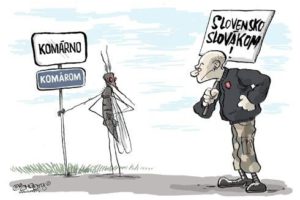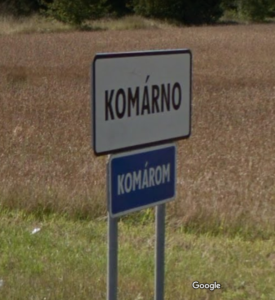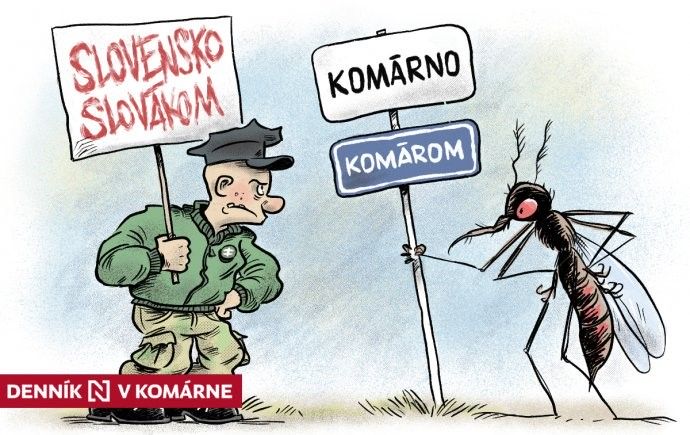Slovakia for Slovaks. Source: dennikn.sk

Source: Shooty. © Martin Šútovec, used with the permission of the author.
What do we see?
The cartoon, produced by the artist Martin Šútovec (Shooty) as a commentary piece for the Slovak mainstream daily Sme/Denník N, shows two participants: a mosquito and a young man, both holding what appear to be political banners. Upon closer inspection, we can see that the mosquito is actually leaning against a conventional street sign which bears the name of a large Slovak city, Komárno. Underneath, there is the official Hungarian version of the name, Komárom. Facing the mosquito is a young bald-headed man. He is shown wearing a green jumper with a double cross (the national symbol of Slovakia), camouflage pants and black boots in what appears to be a conventional visual representation of a right-wing extremist. The young man is directly looking at the mosquito and his gaze is filled with hatred. He holds a placard with the inscription “Slovakia for Slovaks”. At first sight, there seems to be no humorous element to the cartoon. The humour, in fact, is the result of a complex and intricate word play based on inter-language homonymy that enables Slovak viewers to interpret the bilingual city sign as ‘Komárno for mosquitoes’. The cartoon makes a poignant point about traditional nationalist tensions within the country and has been re-used in various media on multiple occasions.
What public issue is being addressed here?
The cartoon addresses a specific locality in southern Slovakia: the city of Komárno/Komárom, located right on the border with Hungary. Being divided by a river (the Danube), one part of the city belongs to Hungary and the other to Slovakia. The Slovak part of the city is located in a region with mixed ethnic population, and is inhabited by a very high proportion of Hungarian speakers (according to the 2011 census, they have the majority of 53 per cent in the city).
The bilingual city sign is directly linked to the issue of language rights of the Hungarian minority in southern Slovakia. This is an example of a linguistic landscape (cf. Cenoz and Gorter 2006), which reflects the underlying tensions between various ethnic groups living in a single state – a situation that is well known from various other countries (e.g. Ireland, Spain, Canada). The issue of language rights, including the visible presence of the Hungarian language in the public spaces in areas populated by speakers of Hungarian, has been a long-standing bone of contention in official language policies in Slovakia, particularly in relation to the potential Hungarian irredentism in the region.
In addition to indexing the minority language rights struggle in an ethnically mixed area, the cartoon makes a point about the nationalist movements calling for an ethnically and linguistically uniform country. The intolerance is reflected in the slogan ‘Slovakia for Slovaks’, which mirrors the possible – but completely wrong – reading of the bilingual sign. The incorrect understanding of the meaning by the Slovak nationalist can be interpreted as the result of his limited knowledge. Ultimately, the cartoon may function to showcase the lack of substance of nationalistic sentiments and, thus, to contribute to delegitimizing such intolerance. Slovak readers, who can spot and appreciate the punning word play, can likewise feel a sense of superiority at the expense of the nationalist, who evidently misunderstands the situation.
What does the humour do?
The humour relies on an inter-language pun: the two possible and divergent meanings of the word ‘Komárom’ in Slovak and Hungarian. In Hungarian, it is a proper noun, designating the official Hungarian name of the city, while in Slovak, it happens to be an inflected form (dative singular) of the common noun (so-called ‘appellative’) of ‘komár’ [mosquito], meaning ‘to/for mosquitoes’. Thus, the word is a homonym – a word with the same form but different meanings. The humour arises from the target audience’s ability to (1) read the sign ‘KOMÁRNO KOMÁROM’ in a syntagmatic manner as a slogan with a distinctly political meaning (‘Komárno for mosquitoes’), and (2) perceive the silliness of the nationalist who counters that erroneous reading by carrying the intolerant and provocative placard ‘Slovakia for Slovaks’. The viewers are prompted to opt for the humorous, nonsensical reading of the city sign by the presence of the mosquito in the cartoon. Interestingly enough, the cartoon captures a stand-off situation between the two figures, who are representative of the respective ethnic groups. While the mosquito is present in the cartoon for no other reason than the simple phonological similarity between the Slovak word komár [mosquito] and Komárno, it is actually often the case that various outgroups (e.g. migrants) are represented metaphorically in a dehumanized manner – both visually and verbally.
Bibliography
Cenoz, Jasone, and Durk Gorter (2006) “Linguistic landscape and minority languages.” In: Gorter, Durk (ed.) Linguistic Landscape: A New Approach to Multilingualism. Clevedon: Multilingual Matters, 67-80.
https://komentare.sme.sk/c/4174201/shooty.html
https://dennikn.sk/2548852/vsetci-slovaci-su-pastieri-z-hor-vsetci-madari-su-barbari-z-azie-stereotypy-to-nie-my-to-iba-oni-slovensko-madarska-anketa/

The real bilingual city boundary sign in Komárno in Slovakia.
Source: Google Streetview, July 2018
